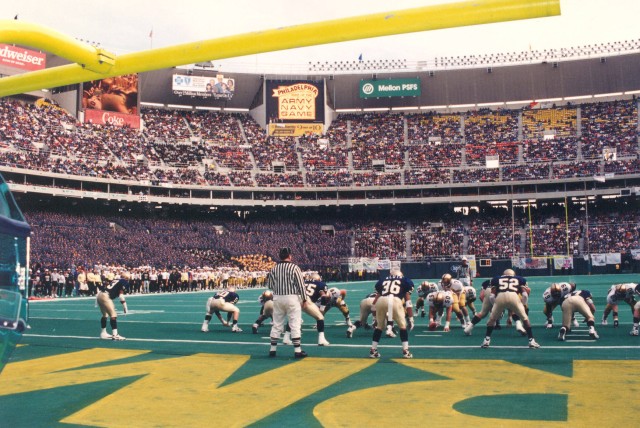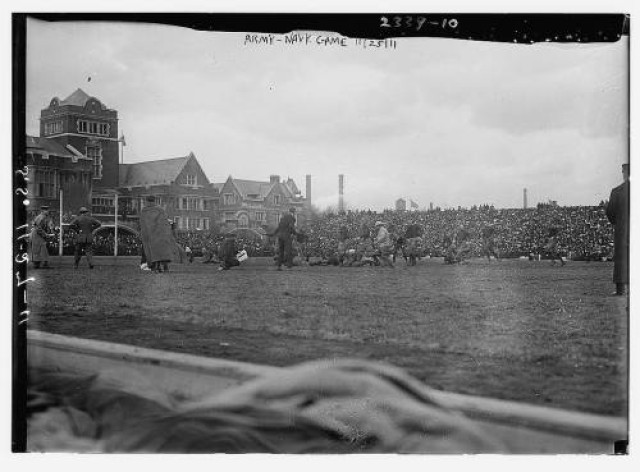November 29, 1890, marked the beginning of the greatest rivalry in all of American sports: Army-Navy football, which came about primarily because of the efforts of Dennis Mahan Michie. Born at West Point to a prominent faculty member who had been brevetted brigadier general for Civil War service, Michie learned how to play football at Lawrenceville Prep. He entered West Point in 1888 and began to contrive a way to bring that sport to the Military Academy. Navy already had a team. Michie knew that the USMA Academic Board was reluctant to approve such a contest, but he got Navy to issue a challenge, and convinced his father, a professor of natural and experimental philosophy (physics); Commandant Hamilton S. Hawkins, and Superintendent John M. Wilson that the pride of West Point was at stake. They helped persuade the Academic Board to permit the contest but only with the condition that the game be played at West Point.
The 271 members of the Corps of Cadets contributed 52 cents each to pay half of the Navy traveling expenses. Young Michie served as captain, coach, trainer, and business manager for the Army team. He gathered volunteers throughout the Corps to play, but only three had any experience with the sport, and usually they could practice only on Saturday afternoons whenever bad weather cancelled drill or parade.
The Midshipmen arrived by special ferry on game day and grabbed a feisty goat from an Army NCO's quarters as their mascot. The game was played on a gridiron marked off on the Plain. The much more experienced Navy team dominated that first contest, winning 24-0 in front of a good crowd.
That result did not sit well with Cadet Michie, who was determined to best the Middies. He found a competent coach named Harry Williams teaching in nearby Newburgh, and the officer-in-charge of football, LT Denny Tate, persuaded Williams to visit West Point twice a week to work with the team.
The 1890 result also did not sit well with Superintendent Wilson, who approved an unprecedented trip to Annapolis for a rematch. The 1891 Army team was much better prepared to battle the Midshipmen, having won three games, tied one, and lost only to powerful Rutgers. Michie starred in Army's 32-16 romp. Both teams attended a big dance at the Navy boathouse that night, and the players congratulated each other on a fine game. At the event's conclusion, Michie shook hands with Worth Bagley, Navy's star quarterback, and they wished each other well.
Bagley and Michie exemplified the special nature of the Army-Navy rivalry not only on the field but also in their service and sacrifice off it. Both would lose their lives in the Spanish-American War in 1898. Bagley died aboard the USS Winslow on patrol duty near Cuba, the only Naval officer killed during the conflict. Captain Michie, whom General Hawkins had selected as aide-de-camp, was organizing the brigade for an assault during the Battle for Santiago when he was killed by a Spanish marksman on July 1. He was only 28 years old. But his legacy is still evident on those fall Saturdays at West Point when the Black Knights battle opponents in the famous stadium that bears his name. And the legacy continues as well in the continuing contest between the Army and Navy football teams, which will meet for the 110th time this year in the game that is the real Super Bowl of American sports.
ABOUT THIS STORY: Many of the sources presented in this article are among 400,000 books, 1.7 million photos and 12.5 million manuscripts available for study through the U.S. Army Military History Institute (MHI). The artifacts shown are among nearly 50,000 items of the Army Heritage Museum (AHM) collections. MHI and AHM are part of the: Army Heritage and Education Center, 950 Soldiers Drive, Carlisle, PA, 17013-5021.






Social Sharing